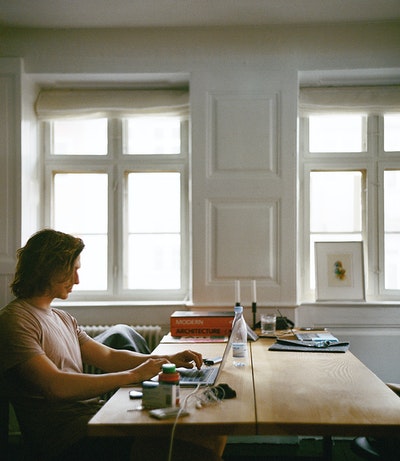It’s Time For A Self Health-Centered Home Office

The COVID-19 pandemic has introduced new habits for the working population. A lot of companies have been forced to shut down during the first wave, encouraging their staff to work from home.
As a result, a few weeks into the beginning of self-isolation and lockdown periods, the average worker found themself bombarded with how-to guides and best practice tips for their new home office lifestyle.
From what to wear to how to behave in Zoom meetings, remote workers only need to spend a few seconds on Google to find their answers.
But despite the abundance of information on how to best work from home, the home office lifestyle still lacks direction. It might sound surprising, but many of the best practice recommendations could be counterproductive and lead to excessive stress.
For a lot of professionals, working effectively outside of the workplace was a major routine disruption. Needless to say, it takes time to create new habits and figure out what works for you.
However, if you have decided to work from home permanently, you need to create a home office arrangement for you. And yes, that means forgetting Google tips and lifestyle blog articles to connect to your inner self and address unrealistic home office advice that could affect your health.
Let it move with you
Most workplace health guidelines mention the need to take regular breaks. However, modern workplaces tend to include a break room, such as a lounging or kitchen area, which makes it easy to remember to get away from the desk now and then.
When you’re working from home, things can be different. The need to take frequent breaks is still there, but it tends to get unnoticed when you’re too engrossed in your tasks.
There aren’t any coworkers around to invite you to a chat over a coffee or a quick game of tennis table – depending on the facilities available. As a result, you tend to spend more time sitting down when you work from home.
Unfortunately, while we all know that a prolonged sitting position is harmful to your health, the home office makes it hard to remember to stand up and walk for a few minutes.
Natural breaks are less frequent at home. But you can help your body go through the motion of work and reduce sitting time with an adjustable standing desk. A desk that can stand with you when you need it helps you stay comfortable and healthy all day.
What’s the benefit of a desk that follows your body? It ensures you can stand up throughout the day when you need to stretch out your legs without losing your focus on the job.
The thing about regular breaks
It is fair to say that a standing desk that can adjust to different work positions doesn’t replace frequent breaks away from the desk. However, when you work from home, you are less likely to get distracted by coworkers.
As a result, you tend to invest more time and focus on your tasks, pursuing thoughts and ideas further than you would in the workplace. Consequently, you can’t schedule breaks in the same way you would in a business. Stopping your thought processes or your Zoom meeting for a quick walk around the house disrupts your work and costs time.
Don’t force breaks. You are not a machine. Your creativity sets the pace throughout the day. Therefore, a home office suitable for mental focus allows flexibility for cognitive and physical rest, either during or after work.
You need a thinking platform
The human mind is continually working. However, your brain compiles thoughts and ideas without order or organization. You may be thinking of what to eat for lunch, and the next second you find yourself wondering how to solve a work problem.
There is no rule as inspiration and creativity can come from many places. Therefore, making the home office a productive place begins by leaving room for those natural and diverse thinking paths.
If you’re a hands-on type of person, you might find a notice board useful. Adding a corkboard wall to the home office lets you pin down thoughts, projects, inspirative designs, and everything in between, from kids’ drawings to hierarchy plans.
Alternatively, if you prefer a sleek decor, you can use magnetic paint to turn a wall into a magnetic board. It’s the ideal place to keep printed instructions from your VIP clients and football schedule magnets from MagnetStreet.
There’s nothing wrong with mixing everyday life with work on a thinking board. On the contrary, it’s guaranteed to boost your creativity!
There is such a thing as over-organized
Have you come across organization tips and tricks for home offices? Color-coded labels and boxes are a popular addition to the office as they create an elegant tidiness.
A place for everything and everything in its place. Yet, the popular saying fails to consider the counterproductive cost of over-organization. Indeed, a tidy home office makes it easy to find everything you need and get going through the day.
However, Instagram-worthy home offices are a waste of your time and energy. Ideally, you want simple space and document management practices. Staging your furniture and stationery by size, color, or Feng Shui feature may seem like a good idea on paper.
In real life, it means that you’ll have to constantly arrange your working space to suit aesthetic rules. It is going to waste a lot of your productivity on a day-to-day basis. Additionally, the process of creating and maintaining a social media-friendly desk can become stressful.
Make it a place you own
Decorating your home office is always a good idea. Most professionals spend around 8 to 10 hours at their desk, every working day. Therefore, it makes sense to design a home office that feels cozy and pleasant.
Typical home office design guidelines tend to include a choice of colors that enhance cognitive functions. Green, yellow, and blue are the designers’ favorites to optimize creativity, productivity, and focus. However, a common mistake for work-from-home people is to emulate the designers’ photos.
Creating a home office that works for you is about embracing the designs you like, rather than reproducing a decor that doesn’t reflect your personality and tastes. What difference does it make?
Believe it or not, but it makes a huge difference to your mental focus and boosts to sit in a space that you love.
No, you really, really don’t need fancy coffees
What should you drink at your desk? There’s a variety of choices to pick from, from tea to coffee drinks. But the favored drink of the pandemic has been the Dalgona coffee, a whipped coffee drink introduced by a South Korean TV show.
The recipe consists of a couple of tablespoons of instant coffee mixed with the same amount of sugar and water and whisked together until it goes thick and glossy.
Then you place the mixture on top of the milk or milk substitute, almost like a reversed cappuccino. If you’ve been working from home since March, chances are you’ve uncovered a few yummy recipes like this one.
Unfortunately, many popular home office drinks are rich in sugar and fat, making them unhealthy alternatives for day-to-day drinks.
Don’t share it
You need to be selfish about your home office. While coworking spaces used to be trendy in the creative field, your health and sanity require a solitary and confined home office.
Working from home doesn’t have to be a lonely event, as you can reach out to coworkers and clients via Zoom meetings or other interfaces. Nevertheless, sharing your office with someone else can affect your focus and cognitive process.
The presence of another individual in a small room inevitably leads to distraction, which can slow down your work and thinking process. Have you noticed how a lot of people tend to voice out ideas when they work alone?
It encourages creativity and cognitive development, something you can’t do if you bring someone else into your home office.
The no snack rule is a bad rule
If you’ve been reading dietary advice for home office workers, you’ve probably filled your kitchen cupboards with peanut butter, apples, and healthy nuts.
Snacking at your desk could be potentially harmful, as in the long term the habit could encourage weight gain and blocked arteries.
However, it doesn’t mean that you have to impose a strict home-based office diet that consists of fruits, vegetables, and lean proteins. Your brain needs the energy to think throughout the day.
Typically, the brain consumes around 20% of your daily energy and relies on glucose as its main source. People who embrace a low carb diet can experience brain fog as the body readjusts to meeting the glucose demands.
But a low carb diet doesn’t erase cravings. Sometimes, it’s best for you to have a cookie and get a boost of brain energy, rather than eat an apple and feel miserable about it! Indulging in moderation is good for your mental health.
In conclusion, the home office arrangement needs to be updated to meet people-focused requirements. Listening to your body and mind can feel like you’re going against some of the most well-respected home office tips. But creating a space that works for you begins by putting yourself at the center of the design, rather than trying to retrofit your needs afterward!






